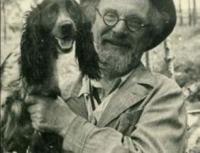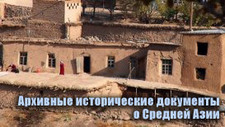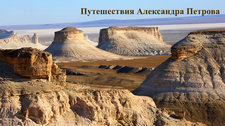Вы здесь
Prishvin in Karkaraly Mountains.

Ecological excursions in Karkaraly Park.
“A land of unkissed skies. Of winged rivers, a vastness for the soul.
And the smallest details drown in you before the eyes of these mountains.
Snow inaccessible, unearthly - no dark spots, no traces.
And you brighten from the snow - partner in Eternity itself.”
Leonid Zamyatin.
Trip from Almaty to Karkaly Park.
Reputed writer M.M. Prishvin (1873–1954), a correspondent for the newspaper “Russkie Vedomosti,” chose Siberia as the next destination on his travels. He set off to write about the resettlement of peasants to free lands. On the way, while carefully studying the book "Kirghiz Region," he read that wild steppe sheep, argali, were found somewhere near the city of Karkaraly (Russia. Kirghiz Region 1903: p. 121).
In Omsk, the writer wanted to try his luck at hunting. On August 13, 1909, in a tarantass with a companion, the wife of a Karkaraly forester, M.M. Prishvin set off for Karkaraly via Pavlodar and Bayanaul (Prishvin 2007: pp. 471–580) in a tarantass.
The visitor from the capital had no accompanying papers. M.M. Prishvin was forced to turn to Semipalatinsk. On August 24, the Semipalatinsk subdivision of the IRGO noted:
"A letter from ethnographer M.M. has been reported." Prishvin, a member of the Russian Geographical Society, requested assistance in his ongoing collection of ethnographic materials and the recording of Kyrgyz legends and traditions in the Karkaraly district, in view of the unforeseen obstacles he encountered on the part of the administration…”
(Notes of the Semipalatinsk Subdepartment, 1911, p. 26). The committee members sent the St. Petersburg resident an open letter from their subdepartment and elected him a member-collaborator of the Semipalatinsk Subdepartment. On September 3, Prishvin set off with hunting enthusiasts to the Kyzyltau Mountains (Popov, 1981, pp. 165 – 160).
The writer finished his Karkaraly diary on April 2, 1910, although he returned to St. Petersburg on October 4, 1909. Reflecting on the results of his trip to the Kyrgyz steppe, M.M. Prishvin wrote on October 15: “I am an ethnographer.” The book will be like "Kolobok," but coherent and consistent.
To avoid the mistakes of "Kolobok": lack of consistency and gaps in ethnography. To avoid the mistakes of "The Invisible City": subordination to the bare artistic idea..." It was possible to decipher and voice the names of a number of people who, to one degree or another, assisted M.M. Prishvin in his endeavors.
These include the Karkaraly officials K.I. Akimov, V.V. Volzhensky, D.I. Chanchikov, Ya.V. Sitnikov; the paramedics popular in the Steppe Kh. Bizhanov and A. Kurmanov; the brothers Khasen and Magat Akayev; the storyteller M. Tolybaev; the Chingizid S.M. Kozhikhanov; the Karkaraly townsman L.I. Debogan; the Cossack of the Karkaraly stanitsa A.I. Tysyatsky; the forester of the Karkaraly forestry L.S. Gardener, volost clerk of the Kuvskaya volost, L.S. Utkin, and others (Popov 1976, pp. 23 – 25; 2006, pp. 149 – 158; 2008, 2008, pp. 100 – 111; File 1917; Memorial Book 1912).
M.M. Prishvin's ancient tale "Kozy-Korpesh and Bayan-Sulu" is full of love lyrics. The entire steppe knew the poem's content. The Kazakhs were proud of their countrymen, especially the girl Bayan. Geographical features in the steppe are associated with this legend: Mount Tarak (here Bayan forgot her comb), Mount Narshoky (here a camel got lost), and Mount Karkyra, otherwise known as Karkara (here Bayan left her headdress).
This is M.M. Prishvin noted August 16th in his diary. The name Bayan appears in entries for August 24, 25, 26, and 31, and September 2, 14, and 15. For Prishvin, Bayan becomes a popular symbol of love for his native land. On September 2, M.M. Prishvin discusses his plan to write an essay about Sary-Arka.
"An agent with Singer's cars advises going to a remote steppe town in the mountains. I didn't immediately remember its name, but it means 'Black Feather.' Bayan, they told me, lost a black feather - a headdress - in the mountains, and the place was named 'Black Feather' in her honor."
On September 14, Prishvin clarifies that the place where Bayan left the comb is not simply Tarak, but Altyn-Tarak - a golden comb. In St. Petersburg on October 6, 8, 13, and 19, M.M. Prishvin reworks the legend of love. This is how the steppe sketch "At the Devil's Lake" appeared, published in "Russkie Vedomosti" (March 25, 1910).
M.M. Prishvin also noticed in the Steppe the tendency of young girls to adorn themselves with the feathers of various birds, especially owls, as a talisman against evil. The bride's attire is described as follows: she is "in a scarlet velvet dress with gold stitching, in three-colored Bukhara boots made of scaly donkey leather, in a pointed conical cap, strung with beads and decorated with owl feathers and a dark green, artfully arranged drooping feather, long nets, tassels, and braids..."
The aul and yurt are an important element of the material culture of the steppe Kazakhs. "A forester recounted a Kyrgyz song in which the steppe is compared to a yurt." M.M. Prishvin wrote about this in his diaries. "August 21st. The aul of Tokmet.
Consists of seven yurts. In the evening, herds flock here. First, the lambs are gathered. They are tied to loops on a long rope, head to head. Then they begin milking the cows and goats. The guests are accommodated in the white yurt of the recently married son.
There are carpets and pillows, a low table, chests made of frozen tin, a painted bed, and a kerosene lamp.
August 24th. Jaim's village. It has six yurts. They are distributed as follows:
1. Yurt of old aksakal, owner of village.
2. Yurt of his son.
3. Yurt of his second son.
4. Yurt of two younger brothers.
5. Yurt for the horse herders.
6. Yurt for the sheep herders.
The herd of horses remains in the field overnight. The cows graze nearby. Lambs are tethered during the day, and in the field with their mothers during the day. The women collect dung for fuel. In the village of Kh. Akayev, the volost manager, there are 14 yurts.
The owner occupied four. One was for his senior wife, the second for his junior wife, and the third for his mother. The fourth was considered a guest yurt. Ten yurts were allocated to the shepherds and employees of the Kuvskaya volost administration (a teacher, translator, clerk, and poet).
In the spring and fall, the villages migrate to the zhailau and kystau, respectively. They travel up to 15 miles a day with their herds, from well to well. They rest in a light tent made of poles and felt – a zhapa. On September 21, the writer encountered a caravan of nomadic steppe dwellers.
A man rode ahead on a cow. Behind him, a cart covered with felt. Then a woman on a horse, and another woman in a cart. Small children lay in baskets on either side of the camel. Two more camels pulled a cart with older children. The village cattle gathered around the caravan.
On September 6, M.M. Prishvin took part in assembling a Kazakh yurt. It was assembled in 45 minutes. One person held the circular ribs (kerege) for the fastening. Others inserted them into the dome-shaped poles. Then the bottom was lined with a chia mat.
The frame was covered with felt. The very top (shanyrak) was covered with a felt canopy. Kazakh craftsmen achieved great skill in yurt construction. According to Kh. Bizhanov, in the Northern Balkhash region, there are people who spend the entire year in a yurt.
For the winter, they strengthen and insulate their felt house. Cattle graze nearby under the family's supervision and are better fed. M.M. Prishvin notes the exceptional hospitality of the steppe inhabitants. They will always slaughter a ram or a horse.
If a traveler pitches a tent in the steppe, they are invited to a yerulik (festival). They are treated to treats and given gifts in the form of animals. In H. Akayev's village, 40 mares were milked daily, 20 liters of kumiss were drunk, and two cattle were eaten.
The owner of the village dined with his family, children, and herdsmen. He himself poured kumiss for the guests from a wooden bowl with a large wooden spoon. When tea was served, royal caramel, red zhamki, and confectionery cookies appeared.
Besides the traditional beshbarmak, where M.M. Prishvin was presented with an ear as a symbol of better hearing, there were also kuvardak and liver dishes. Guests were served sharp knives for cleaning bones. The head was gutted separately and served to the honored guest.
A variety of foods were prepared from milk: kurt – sour-tasting "pebbles" made from sheep's milk, yrymshik – yellow peas made from boiled milk, sarymai – cow's butter, kuyryk – mutton butter, ayran – sour milk, like yogurt, and katyk – the same ayran, but thicker and richer.
The inhabitants of the Steppe experienced certain difficulties with bread. Wheat was sown on the Tokrau River and its tributaries. The cultivated areas were irrigated by togans (aryks). They prepared akbidai – wheat fried in lard. There were several mills on the Tokrau.
Baursaks – doughnuts fried in lard – were made from flour. The writer's diary contains many details of Kazakh everyday life.
Kazakh clothing. A young woman wears a white headscarf. This signifies her first year of marriage. Then she will wear a white kimishek headdress. In other places, this headdress is called a dzhaulyk. Girls decorate their braids with coins.
The hunter Kali wore a quilted beshmet. Prishvin himself was outfitted for hunting like this: an ermine beshmet, a robe over it, boots (saptama etyk), and a belt with a whip. In the villages, they wear colorful trousers, robes, and malakhai. Kazakh crafts. M.M. Prishvin noted local wool products. To obtain wool, rams are sheared twice – in June and September. The wool is then made into felt mats. Excess wool is sold at the Koyandy Fair, from where it is transported to Petropavlovsk.
Horsehair is used to weave ropes.
Kazakh disputes. All disputes are resolved by a judge, a wealthy, just aksakal. If his verdict is unjust, he receives the title of boksakal ("shithead"). In other cases, the dispute is resolved independently. Both sides begin to steal each other's cattle, leading to a barymta. Then the district authorities intervene.
Kazakh beliefs. In the Bektau Ata mountains, there is a cave called Aulie (a holy cave) with spring water. Infertile women spend the night here in prayer. If a father has performed the Hajj to Mecca, his daughters-in-law may paint their nails red.
If you dream of wealth, you will be rich. If the star Sholpan (Venus) sinks low, the winter will be cold; if it rises quickly, the winter will be fine. Other names for the stars: Esek-Korgan (the death of donkeys), Temir-Kazyk (iron floor), Kus Zhol (bird path). There is a popular belief about the Big Dipper and seven thieves.
Kazakh hunting. The main trophy is a tiger from the reeds of Balkhash and Chu. Its pelt can fetch up to 50 rubles. Young tiger cubs are driven to exhaustion, pinned with pitchforks, and wrapped in felt. Golden eagle hunting attracts 10-15 people. Prishvin describes methods for capturing eagles, their upbringing, and care.
Bustards are hunted on camels, which the wary birds allow to approach quite closely. Hunting argali with the hunter Kali takes center stage in the diary: "The argali lie with their heads in different directions. A guard stands at the highest point. If the dogs are good, they are driven to the rocks, where they look down from there, ignoring the hunter.
When they lie there, you can only stick your head out once to shoot; they won't let you look twice" (Prishvin 1975, p. 95). Kazakh proverbs and sayings. M.M. Prishvin considered them an important part of folklore. He recorded seven sayings on September 8, three on September 10, and one on September 12.
The writer's informants were the hunters and guides Kali and Tokmet. One of the proverbs Prishvin recorded says: "If your comrade is one-eyed, try to squint your eye to be a match for him." The desire to understand the culture of the steppe people and comprehend this unique world dominates the pages of M.M. Prishvin's diary.
The names of Semipalatinsk experts on the steppe are woven into the fabric of the writer's experiences. Among them is the artist V.N. Beloslyudov (1883 – 1916). Prishvin planned to meet members of the SP ZSO IRGO and its director, D.N. Troitsky.
However, the St. Petersburg native never made it to Semipalatinsk. However, the Semipalatinsk Museum of History and Local Lore holds the original letter from M.M. Prishvin to the Semipalatinsk subdepartment, dated February 26, 1910.
"M.G.! In response to your inquiry of January 23, 1910, I have the honor to inform you that I can write an ethnographic article about the Kirghiz of the Karkaraly district only after completing my artistic description of the region, which will begin publication in May in Russkaya Mysl.
With deep respect, M. Prishvin." M.M. Prishvin's stay in Karkaraly and his work were promoted by his teacher P.P. Beldytsky. Economist S.M. Freidenberg (1904–1985) informed me: "From 1926 to 1928, I lived in Karkaraly. In the evenings, we would gather for tea at Avgusta Andreyevna and Pavel Petrovich Beldytsky's.
The host himself was an excellent connoisseur of world literature. M.M. Prishvin's novel "Kashcheyev Chain" was just then published in the magazine "Novy Mir." A dispute arose about its literary value. It was then that Prishvin and Beldytsky's long-standing acquaintance came to light. Beldytsky offered to go and show them the house where the author of the novel had stayed in 1909. M.M. Prishvin wrote several articles and essays reflecting ethnographic material from the lives of the Kazakhs of Sary-Arka: "The Black Arab," "Adam and Eve," "At the Devil's Lake," "Salt Lake," "Argali," "The Eagle," and "The Bear's Coat."
Bibliography:
Case. Semipalatinsk. 1917. September 26.
Notes of the Semipalatinsk Subdepartment of the West Siberian Branch of the IRGO. Semipalatinsk, 1911. Issue V. Russia. Kirghiz Region. St. Petersburg, 1903, Vol. 18.
Memorial Book of the Semipalatinsk Region for 1912. Semipalatinsk, 1912.
Popov, Yu. G., Karkaraly Patterns. Alma-Ata, 1976.
Popov, Yu. G., Karkaraly. Alma-Ata, 1981.
Popov, Yu. G., Ethnographer and Historian F. A. Fielstrup in Kazakhstan. University Museums: Past, Present, Future. St. Petersburg: St. Petersburg State University Press, 2006, pp. 149 – 158.
Popov, Yu. G., Khasen Bizhanov. Karaganda: KarSU Press, 2008.
Popov, Yu. G., Keepers of the Karkaraly Pine Forest // Botanical Research of Siberia and Kazakhstan. Kemerovo, 2008b, Issue 14. Pp. 100 – 111.
Prishvin, M.M. “Journey from Pavlodar to Karkaralinsk” // Prostor. 1975. No. 1. P. 95.
Prishvin, M.M. “Early Diary.” St. Petersburg, 2007.
Authority:
Yu.G. Popov. “Ethnographic Materials in the Diaries of M.M. Prishvin during a Visit to the Karkaralinsk District in the Autumn of 1909.”
Electronic Library of the Peter the Great Museum of Anthropology and Ethnography (Kunstkamera) of the Russian Academy of Sciences http://www.kunstkamera.ru/lib/rubrikator/03/03_05/978-5-88431-157-2/







